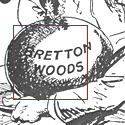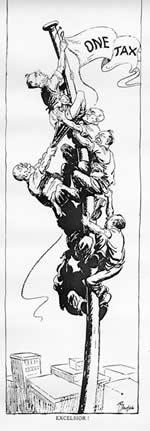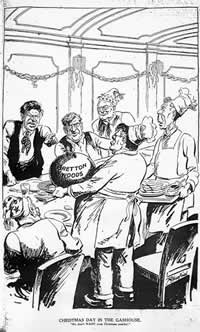

|
|
 |
||||||||
|
|
|||||||||
|
|
|||||||||
|
|
|||||||||
|
|
|||||||||
|
|
|||||||||
|
|
|||||||||
|
|
|||||||||
In his election policy speech of August 1940 John Curtin proclaimed 'We must substitute co-operation for competition and public service for private profit.' He called on Australians to pay attention 'to the planning of our future...The Australian Labor Party is the only political party with a forward-looking policy. It visualises post-war reconstruction to be in the nature of a new social order...economic freedom must be made real by giving security and a rising standard of living to all.' (1)
Amongst the reforms Curtin advocated were national control of banking and credit, national control of interest rates and national direction of investment towards the war effort and postwar reconstruction. Within months of becoming prime minister, Curtin enacted legislation for economic reform that would enable him to put into place his social welfare measures.
Uniform income tax
John Curtin was deeply interested in economic issues and had gained a good grasp of figures at an early age from working as an estimates clerk at Titan Manufacturing. On 19 February 1942 Curtin announced a National Economic Plan which included pegging wages and profits, closing down non-essential industries and taking control of manpower. Arguing that only through unified national control could enough money be raised to prosecute the war effectively and as the states refused to hand over the power temporarily, the Commonwealth took over the entire responsibility for income tax in May 1942, promising to provide compensatory funding to the states if they refrained from imposing their own income tax.
The Bills were challenged in the High Court by four of the states but the legislation was upheld and a High Court decision in 1957 effectively confirmed the 1942 judgment that this power could continue after the war. Curtin and his Treasurer, Ben Chifley, thus used the government's wartime powers to effect a change that would revolutionise the role played by the Commonwealth and produce the greatest single change ever in Australia's constitutional and political structure.
Commonwealth Bank
Private trading and state savings banks cooperated with the Commonwealth Bank during the war to organize domestic and international financial resources for the war effort. Both Curtin and Chifley vividly remembered the conservative monetary policy dictated by the Commonwealth Bank during the Great Depression of the 1930s which did nothing to alleviate the suffering of unemployed workers but instead had forced cutbacks in wages and pensions on those least able to afford it. Curtin and his colleagues ensured that National Security Regulations gave the Commonwealth Bank the ability to provide a centralized and controlled banking system for Australia and in 1945 legislation was passed confirming the bank's central banking control. The bank could then be directed to maintain policies that were of the greatest advantage to Australians, especially in maintaining stability of the currency, full employment and economic prosperity.
'Excelsior!' cartoon
by Ted Scorfield,
Bulletin, 29 April 1942
John Curtin struggles to
implement uniform taxation,
opposed by all the state premiers.
Bretton Woods
Securing Australia's ratification of the Bretton Woods Agreement was one of the most politically difficult but also one of the most important achievements of the Curtin and Chifley Governments. Participation in the agreement prepared Australia for its place in the postwar world of international trade and economics. As Curtin said to parliament in 1944:
Among the things which the world needs in order to have stable conditions after the war is international concert in regard to credit and the provision of the capital necessary to enable countries which have been overrun or whose resources have been exhausted to have purchasing power...[A]greements of this nature are to be welcomed for the purposes of preventing war, rehabilitation and relief and collaboration in the improvement of world standards. (2)
This reflected his earlier beliefs that a practical solution for improving human affairs relied on global cooperation. In a 1923 editorial in the Labor newspaper, the Westralian Worker, Curtin wrote that any practical plan 'for the organisation of the world must have an economic foundation...must include all of the economically essential portions of the world,...will be ineffective if it is confined to any one nation, to any one group of nations or to any one continent...[and] must rely for its fulfilment on world thinking and world organisation.' (3)
In July 1944 a United Nations Monetary and Financial Conference was held at Bretton Woods, a mountain resort town in New Hampshire in the United States of America. At the conclusion of the conference it was announced that delegates had agreed on immediately setting fixed exchange rates for major currencies and the subsequent establishment of two permanent international bodies:
- The International Monetary Fund to oversee and maintain an international monetary system to promote foreign trade and to assist member countries with temporary balance of trade difficulties, and
- The International Bank for Reconstruction and Development to expand international investment to provide the long term capital necessary for postwar reconstruction and development in underdeveloped countries with special consideration being given to countries which had suffered from enemy occupation and hostilities. (4)
There was much anxiety within Australia and particularly within Labor Party circles that a major effect of the agreement would be pressure for Australia to reduce its tariff protection levels and forego its trading advantages with the United Kingdom. Curtin and Chifley believed that the agreements would only be acceptable in Australia if there was also a specific commitment to cooperative effort by member states to promote and maintain high levels of employment and progressively rising standards of living. (5)
However, the Bretton Woods Agreement meant very little to the ordinary voter and after Curtin's death, Prime Minister Chifley had to work hard to convince his colleagues that for the Australian economy to prosper, a climate of international cooperation and planning was essential.
Christmas Day in the gashouse. "We don't WANT your
Christmas puddin'." Cartoon by Ted Scorfield published in the
Bulletin on 11 December 1946.
The Bretton Woods Christmas 'pudding' offered by External Affairs
Minister HV Evatt is roundly rejected by Labor men while Prime
Minister Chifley looks on in dismay.
Australia's ratification of the agreement in March 1947 marked
one of the most important steps in the 20th century towards an
acceptance of the reality that Australia could only develop
economically and socially in the context of the international
trading and economic system.
Full Employment
According to a mid-1942 opinion poll, the common theme of 75% of Australians' dreams was to have better living standards based on secure employment. (6) Curtin had experienced the terrible depression that came after World War One and during the 1930s. In February 1918 he wrote: 'This paper knows no evil so great as that produced by the inability of a man to obtain work...For men to stand idle is absurd. For returned soldiers to tramp the streets heart-brokenly seeking work in the country they fought for is a crime which shrieks to heaven...' (7)
These sentiments were echoed by Ben Chifley writing in the Sydney Morning Herald in December 1943, explaining the Curtin Government's policy on full employment in planning for peace. 'Before the war too many lives were dominated by the fear of unemployment and too little real effort was made by Governments and administrators to banish it...The primary aim of our postwar economic policy must, therefore, be a high and stable level of employment.' (8)
Curtin strongly believed that if people could be fully employed during wartime conditions, then there was no necessity to suffer unemployment during peacetime. It was the role of government to ensure that Australians had access to improved standards of living and the opportunity to raise their families free from economic worries. In 1922 he wrote: 'Unemployment is not a natural or necessary incident of industrial life, but a specific disease of the capitalist order...Our industries are managed by numerous competing and conflicting private interests, individual or corporate, operating planlessly and purely for personal gain. The inevitable result is disorder and chaos.' (9)
Little wonder then that Curtin embraced the concept of committing government to the maintenance of full employment. He made every effort to pursue this objective and ordered the preparation of a White Paper on Full Employment. According to historian Tim Rowse, Curtin, despite being ill and on many occasions absent from parliament, took an avid interest in the White Paper and continued to provide feedback and comments until it was tabled in the House of Representatives on 30 May 1945, just a few weeks before his death. (10)
The 1945 White Paper
'emphasised Keynesian economic principles that linked levels of
employment with expenditure which in turn gives industry the
signals and the motivation to produce.' (11) Following the principles of the
White Paper on Full Employment, nearly a million demobilised men
and women were absorbed into the civilian work force at the end of
the war.
|
|
||
|
|
||

